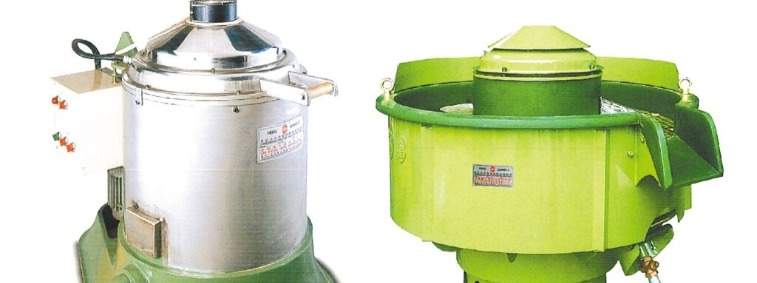Benchmark Data
-
Analysis Report on the Functions of Grinding/Pot Polishing Fluids in Vibratory Finishing Machines
Functional Analysis Report of Grinding/Polishing Fluids in Vibratory Finishing Machines
Introduction
Vibratory finishing machines are widely applied in modern manufacturing for surface treatment of metals, ceramics, glass, and other materials. Grinding/polishing fluids serve as critical auxiliary materials during the finishing process, playing an indispensable role in enhancing processing efficiency, workpiece quality, and equipment lifespan. This report provides a detailed analysis of four primary functions of these fluids: lubrication and cooling, chemical assistance, cleaning and rust prevention, and surface finish improvement, while examining their performance in various application scenarios.
Functions of Grinding/Polishing Fluids
1. Lubrication and Cooling
The finishing process involves high-speed mechanical friction between media and workpiece surfaces, generating substantial heat. If heat is not effectively dissipated, it may cause workpiece deformation, changes in material properties, or surface burn marks. Fluids act as lubricants by reducing friction, minimizing heat generation, and enhancing heat conduction, thus protecting both the workpiece and equipment.
Example: In semiconductor wafer polishing, the fluid’s cooling function maintains wafer surface temperature within safe limits, preventing thermal stress from damaging crystal structures. Typical fluid compositions include water-based solutions with lubricating additives such as polyethylene glycol (PEG) to improve lubrication.
2. Chemical Assistance
In chemical-mechanical polishing (CMP), fluids provide not only physical lubrication but also chemical reactions that facilitate material removal. Fluids often contain acidic or alkaline components (e.g., potassium hydroxide, nitric acid), which react with the workpiece surface to form softer oxide layers or compounds, making them easier for the media to remove.
Example: During silicon wafer polishing, oxidizers in the fluid (e.g., hydrogen peroxide) react with the silicon surface to form a thin silica layer, which is subsequently removed by the polishing media, achieving efficient and precise surface planarization. This chemical-mechanical synergy significantly increases processing efficiency, particularly for hard materials.
3. Cleaning and Rust Prevention
The finishing process generates debris from both the abrasive media and workpiece. If not promptly removed, debris may clog the media or affect processing precision. Fluids, aided by flow and surfactants, flush debris from the working area, maintaining a clean environment. For metal workpieces, rust inhibitors (e.g., benzotriazole, BTA) are often added to prevent corrosion in wet environments.
Example: In steel part finishing, rust inhibitors effectively suppress oxidation, ensuring the workpiece surface remains stable and durable post-processing.
4. Surface Finish Improvement
Fluids regulate the contact between media and workpieces, promoting smoother and more uniform polishing. Some fluids contain nano-scale suspended particles (e.g., silica nanoparticles) that fill microscopic depressions during polishing, further enhancing surface smoothness.
Example: In optical glass polishing, this function is critical to achieve nanometer-level surface roughness, meeting the high-precision requirements of optical components.
Fluid Composition and Selection
Fluid compositions vary according to application requirements and typically include:
-
Base Liquid: Water- or oil-based solutions providing lubrication and cooling.
-
Chemical Additives: Acids, bases, oxidizers, or corrosion inhibitors for chemical assistance or rust prevention.
-
Suspended Abrasives: Nanoparticles such as silica or alumina to enhance polishing performance.
-
Surfactants: Improve cleaning efficiency and reduce debris adhesion.
Selection Considerations: Workpiece material, media type, and finishing goals must guide fluid choice. For example, hard materials like ceramics require chemically active fluids, while soft metals like aluminum prioritize rust prevention.
Application Cases
Industry Workpiece Material Key Fluid Functions Typical Fluid Components Semiconductor Manufacturing Silicon Wafers Chemical assistance, surface finish enhancement Potassium hydroxide, silica nanoparticles Optical Components Glass, Sapphire Surface finish enhancement, cooling Cerium oxide suspension, polyethylene glycol Metal Processing Steel, Aluminum Cleaning, rust prevention, lubrication Benzotriazole, water-based lubricants Ceramic Processing Zirconia, Alumina Chemical assistance, cooling Nitric acid, alumina suspension
Challenges and Future Development
Despite their effectiveness, the application of fluids faces several challenges:
-
Environmental Impact: Some chemical components may pollute the environment, necessitating the development of greener formulations.
-
Cost Considerations: High-performance fluids are costly, requiring a balance between performance and economy.
-
Compatibility Issues: Different workpiece materials and media require fluid compositions to be carefully matched.
Future Trends: With advances in nanotechnology and green manufacturing, fluids are evolving toward higher efficiency and environmental sustainability. Bio-based and recyclable polishing fluids are emerging as key research areas.
-
-
振動研磨機(vibratory polishing / vibratory finishing machine)

Vibratory Polishing / Vibratory Finishing Machine
Maximum Acceleration Formula
A key formula for understanding vibratory finishing performance is:
a=4π2f2Aa = 4 \pi^2 f^2 Aa=4π2f2AThis equation describes the maximum acceleration experienced by objects within the vibratory finishing bowl, which directly affects polishing efficiency and results.
Parameters and Their Significance
-
a: Maximum acceleration applied by the bowl or media to the workpiece (m/s²)
→ Higher acceleration increases polishing efficiency but may also cause damage or instability. -
f: Vibration frequency (Hz)
→ Typical range: 20–60 Hz. Higher frequency increases contact events for more uniform polishing but reduces individual impact energy. -
A: Vibration amplitude (m, usually a few millimeters)
→ Larger amplitude increases impact force; excessive amplitude can cause material breakage or media splashing.
Application Example
Given a vibratory finishing machine with:
-
Amplitude: A=3 mm=0.003 mA = 3 \, \text{mm} = 0.003 \, \text{m}A=3mm=0.003m
-
Frequency: f=50 Hzf = 50 \, \text{Hz}f=50Hz
Substitute into the formula:
a=4π2⋅502⋅0.003≈296 m/s2a = 4 \pi^2 \cdot 50^2 \cdot 0.003 \approx 296 \, \text{m/s}^2a=4π2⋅502⋅0.003≈296m/s2This corresponds to approximately 30 times the acceleration of gravity (g ≈ 9.81 m/s²), a strong force suitable for high-speed deburring or aggressive polishing.
Conclusion
Using this formula allows engineers and operators to:
-
Optimize amplitude and frequency combinations for efficiency and safety
-
Evaluate processing performance and potential workpiece stress
-
Compare different vibratory finishing machines based on their dynamic characteristics
-
